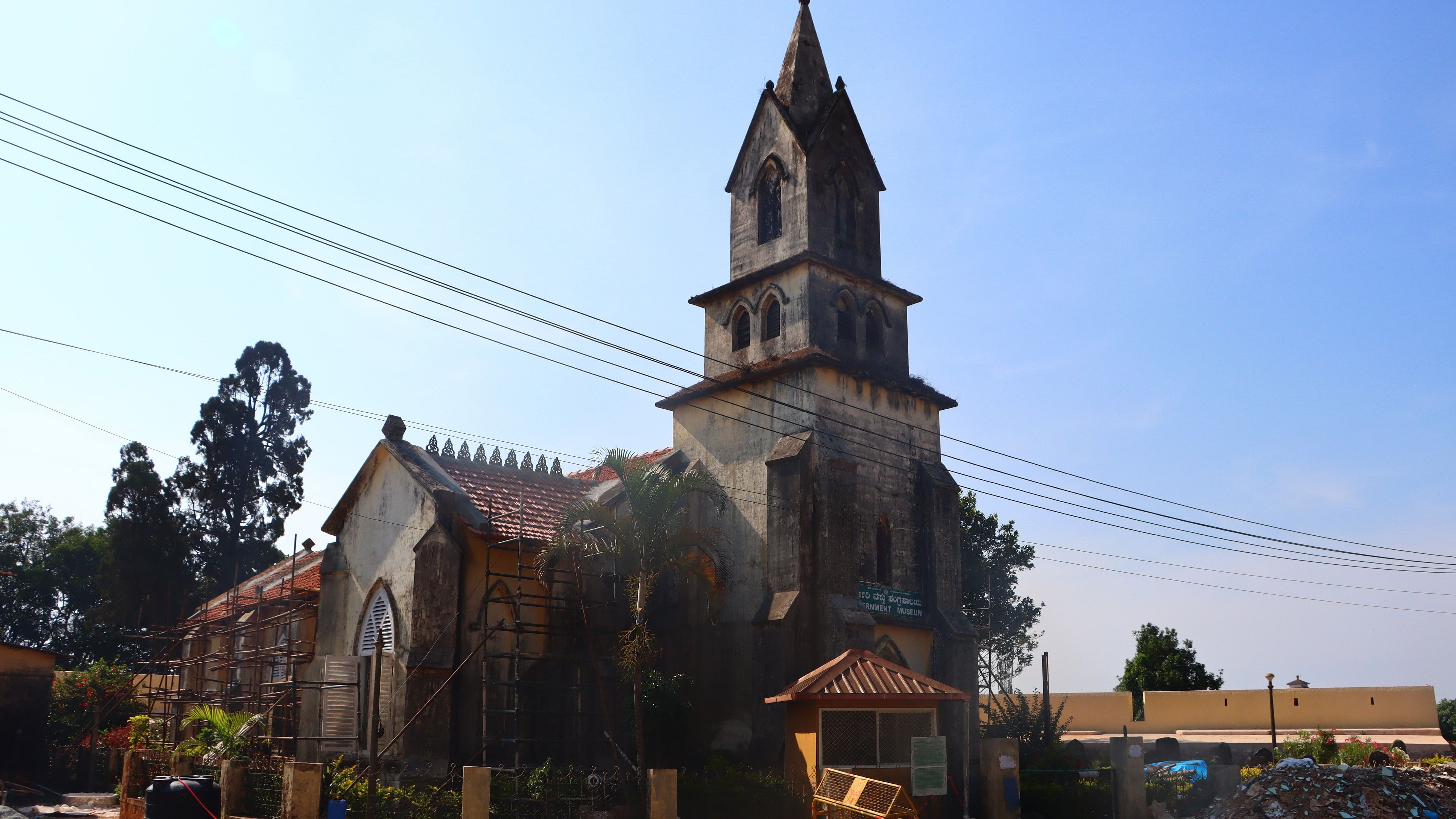
The government museum in Madikeri; (top) Madikeri Palace.
Credit: Photos by author
Madikeri, nestled in the scenic Kodagu district, is a historical gem. Established in 1681 AD by Mudduraja of the Haleri dynasty, it was initially known as Muddurajanakeri. As time passed, it evolved into Madikeri among locals and became ‘Mercara’ for the British. This town is a treasure trove of breathtaking landscapes, mesmerising viewpoints, vast coffee plantations and tranquil streams and waterfalls.
Our first destination in this hill town was the Madikeri Fort, a living testament to the resilience of the Kodagu rajas. Originally constructed from mud, it was later rebuilt using granite masonry and laterite blocks after being seized by Tipu Sultan, who renamed it Jaffarabad.
The fort, an irregular hexagon, echoes the shape of the hilltop. Six circular bastions, each with a small bulbous dome, grace the angles. The entrance, a complex and winding path through three successive gates, faces different directions. The palace, a commanding two-storey structure, square in plan and with a south-facing entrance (currently closed for repairs and renovation), is a sight to behold. A corridor runs along all four sides on both floors and opens onto an inner courtyard paved with granite slabs.
The palace housed the state government office and court complex earlier. An imposing 19th-century church situated in the southeast corner was converted into a museum maintained by the State Department of Archaeology. The empty museum is in disuse today and presents a picture of neglect. The marble plaques in this museum reveal the history of British planters who came and set up coffee plantations. A brass plate inscription in Kannada, English and Urdu mentions the period of palace construction from 1812 to 1814 A D by Linga Rajendra II of Kodagu.
Right in the heart of Madikeri town is Raja's Tomb (Gaddige). Built in the Indo-Saracenic style, these monuments hold the mortal remains of Kodava royalty and court dignitaries. The central tomb is of Raja Doddaveerarajendra and his queen. To the right is the tomb of Lingarajendra, built by his son Chikkaveerarajendra in 1820. To the left is the tomb of the royal priest Rudrappa, erected in 1834. Nearby are buried two royal officials, Biddanda Bopu, who died fighting Tipu Sultan, and his son Biddanda Somaiah.
It is believed that the king himself commissioned the tombs. Crafted from stone, they showcase the architectural brilliance of the era. The two-story structure is adorned with intricate carvings featuring many designs and motifs, including flowers, animals and mythical creatures.
One of the most striking features of the tomb is the series of intricate arches that adorn the walls and ceilings. The tomb also boasts several sculptures depicting Hindu gods and goddesses and scenes from Hindu mythology.
A well-maintained garden surrounds Gaddige Raja's tomb and adds to the site's aesthetic appeal.
Another popular tourist attraction in Madikeri is Raja's Seat, meaning 'Seat of the Kings'. This place was used by the kings and queens of Kodagu, who were the rulers of Karnataka for over 200 years from 1600 to 1834 CE. The garden, known for its scenic beauty, was a favourite place of recreation for the rajas; it was built on a high ground overlooking the cliffs and valleys to the west. It offers a breathtaking view that will inspire and excite nature lovers. The best time to visit is during the winter months of November to February when the weather is pleasant, and the views are at their best.
Every year on January 30, Coorg commemorates Sarvodaya Diwas (Martyrs' Day). The Kodavas walk in procession, carrying an urn containing Mahatma Gandhi's ashes to Raja's Seat. This procession is followed by reciting verses from the holy texts. People sing bhajans, offer floral tributes and observe a few minutes of silence as a mark of respect to the martyrs.
Every trip to Madikeri is complete only after visiting the Talakaveri. It is considered the source of the River Cauvery and a holy place for many Hindus. It is on Brahmagiri hills near Bhagamandala in Madikeri. Here, the river emerges from a spring in a rock formation and flows onto a bigger tank.
Talakaveri is dedicated to the Goddess Kaveramma, the main deity. No photography is allowed at the spot. People also perform puja at the river's origin point, carrying the sacred water away in pitchers.
After a day of exploration, one must also indulge in the local cuisine, which offers a delightful adventure with dishes like chilli pork, bamboo shoot curry and coffee pudding.